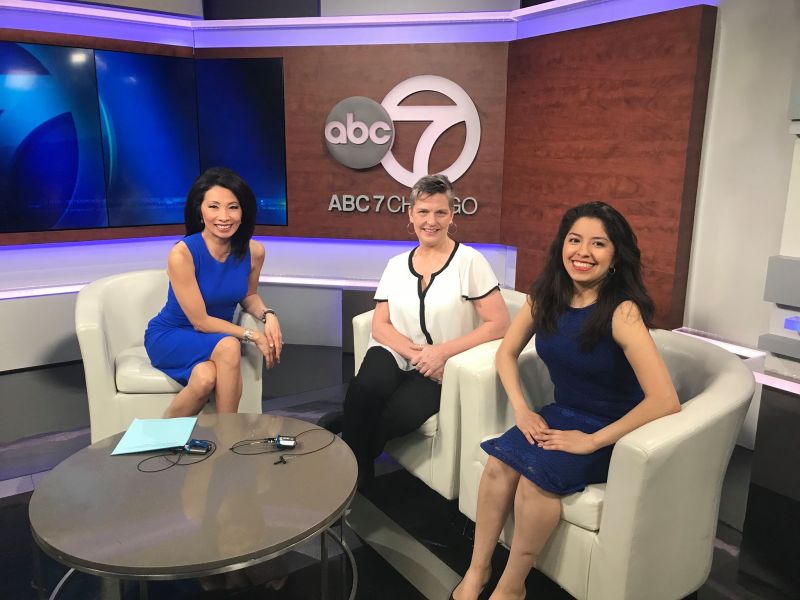Did You Know?
Lynda Lopez, an advocate for transportation equity

Lynda Lopez is on a mission to prove that transportation is about much more than just getting from point A to point B. She contends that creating safe walking, bicycling and public transit conditions are fundamental to creating thriving, vibrant communities in Chicago.
As a reporter for Streetsblog Chicago, Lopez explores how transportation and mobility intersect with social justice and equity, giving voice to the residents and communities that are grappling with these issues.
Her insights and advocacy work around transportation equity have earned her Active Transportation Alliance’s Advocate of the Year Award, which she received several months back at Active Trans’ annual member meeting.
Transportation is access
“Transportation seems to be very niche, but it shouldn’t be because it’s everything that we are. It’s how we move,” Lopez says. “How we move really impacts where we end up, like how you can get to places, what access you have to certain resources, access to opportunities or schools.”
“If people don’t feel safe walking down the street, they’re not going to frequent business districts. If there’s not a bus that connects one side of the neighborhood to the other, are people going to frequent that other part of the neighborhood?” she adds. “It’s really crucial to think about how do people move around the neighborhood and how does that enhance community ties or limit them? How are all of these tied together to make communities livable for people?”
A vision for social justice
Lopez knows firsthand the important role walking, biking and transit infrastructure plays in shaping a strong community. Having grown up in the West Humboldt Park and Hermosa neighborhoods on the Northwest Side of Chicago, Lopez’s family didn’t have a car. They relied on walking and public transportation to get to school, employment and other activities.
In high school and college, Lopez took up bicycling to commute to her jobs. She remains an avid cyclist today, but also uses public transit regularly.
Those life experiences, as well as seeing how The 606 elevated trail has induced fears of gentrification and displacement for residents of Wicker Park, Bucktown, Humboldt Park and Logan Square, sparked Lopez’s interest in writing about how transportation equity is connected to community development and social justice.
Lopez has worked as a reporter for Streetsblog Chicago for the past two years, covering how walking, biking and public transit can transform neighborhoods and improve the quality of life in communities. “I definitely have an intention as a writer,” she says. “How do I use my skills to uplift these issues, especially uplifting marginalized voices and also bringing more nuance around the conversation around transit and mobility justice.”

For a discussion about dockless bike sharing in Chicago, Lynda Lopez (right) appeared with Active Trans Deputy Director Melody Geraci (middle) on ABC7’s “Newsviews,” hosted by Judy Hsu (left).
Telling untold stories
Among the many stories Lopez has written for Streetsblog Chicago, she is particularly fond of one that centers on the highs and lows of bike commuting for working-class Chicagoans — perspectives you rarely see covered by the mainstream media.
For the story, Lopez interviewed Cedric Johnson, 48, a resident of Humboldt Park who commutes to the Loop for his job in sanitation and maintenance, and Jesus Yanez, 48, a construction worker and house painter who lives and works in Albany Park. Both said they enjoy bicycling not only because it saves money, but also for the benefits they derive from it.
Johnson said that cycling makes him “feel free” and gives him “peace of mind.” But he also pointed out that motorists don’t connect with their communities inside a car and that bicyclists can make communities safer because they are more likely to notice and help others who may need assistance.
Yanez echoed those sentiments, adding that cycling offers him relaxation and mental acuity: “Biking helps you focus more, it sharpens your mind. It helps me do better at work.”
“I was really proud of that one because it highlighted people that aren’t usually highlighted when you talk about bikes,” Lopez says. “Both of them looked at biking in a way that goes beyond commuting, which I really appreciated.”
She also likes a story she penned about a march in Logan Square, where demonstrators demanded solutions to the neighborhood’s displacement crisis, including affordable transit-oriented development. “I have a lot ties to communities around the city, so I want to continue to make them proud and represent their stories well,” Lopez says.
Collaborating with Active Trans
Lopez is further broadening her knowledge and sharing her insights on transportation by participating in Active Trans’ Community Equity Advisory Groups. In this group, she is working with other transit advocates, urban planners and civic organizations to develop issue briefs on how walking, biking and public transit are inextricably linked to equity and quality of life.
For example, they are discussing how to improve accessibility to public transit stations for people with disabilities. Another issue they are working on is how to responsibly advocate for walking, biking and public transit conditions while still being cognizant of gentrification.
They are also trying to figure out how to help minorities and undocumented immigrants take advantage of sustainable transportation options and allay their fears of being targeted by the police.
Lopez says working with Active Trans’ Community Equity Advisory Groups reinforce why she advocates for transportation equity: “I want to bring more nuance to the conversation around transit and development. I want people to think about the intersections they didn’t think about before. That’s a big goal of mine.”
Photo: Lopez appears in top photo with Active Trans Campaign Organizer, Robert Schultz.
Make a Donation
Your tax-deductible donation supports the important work that Active Trans does throughout the region
